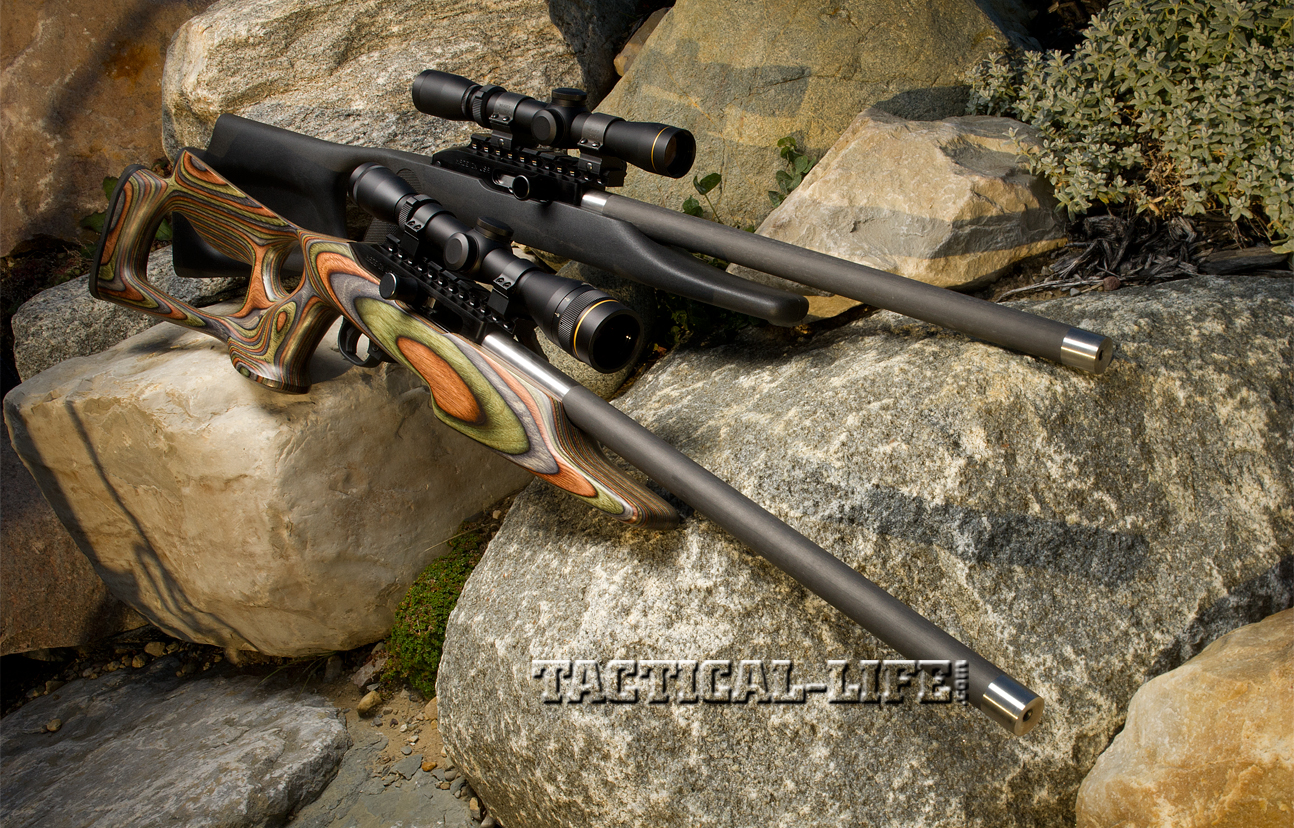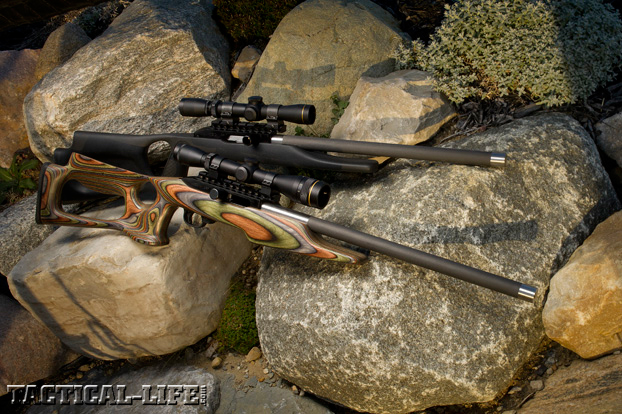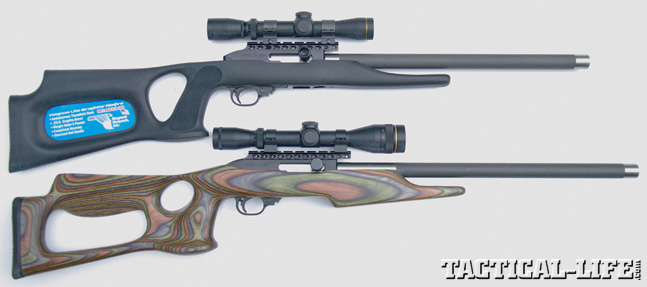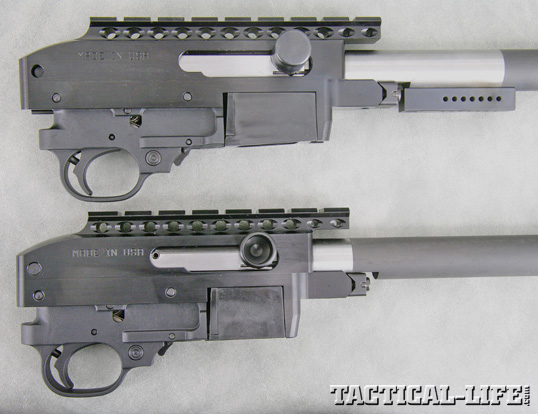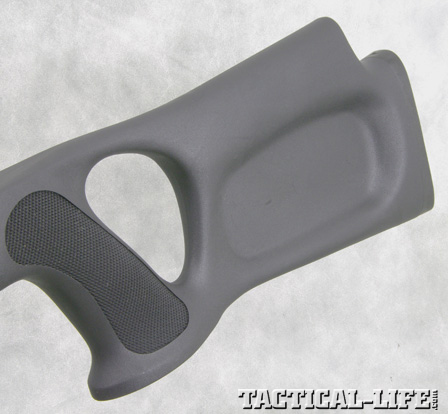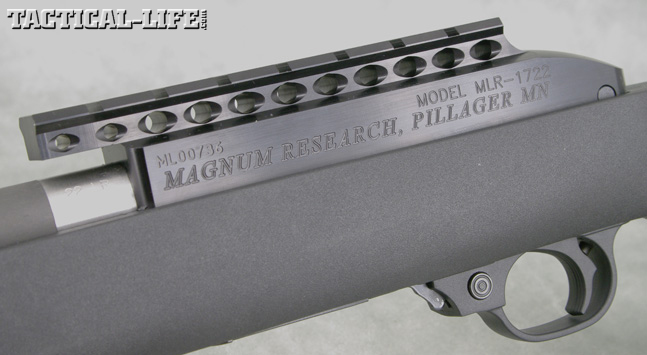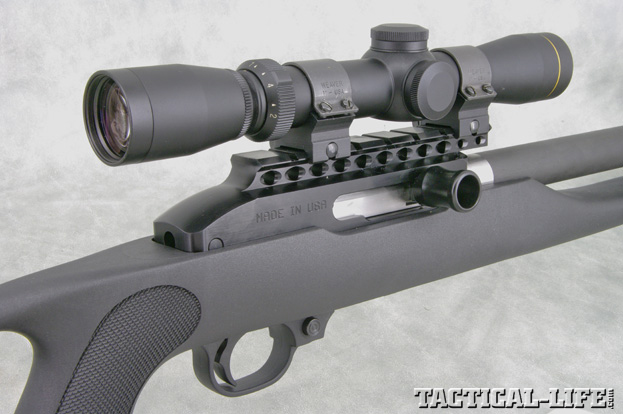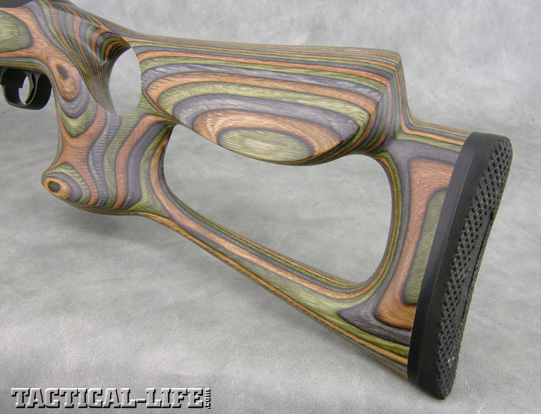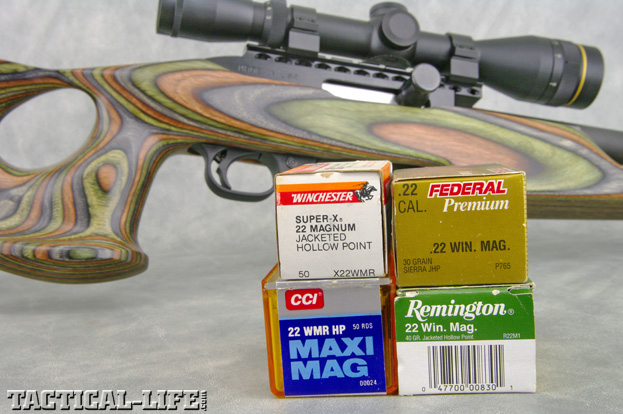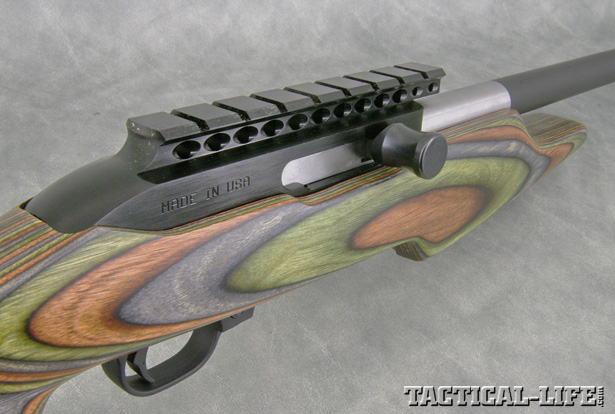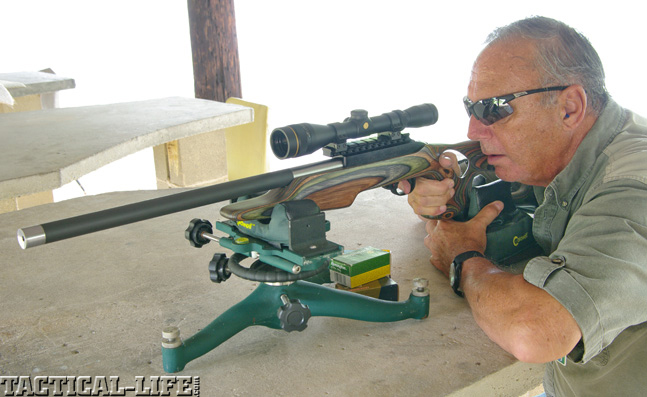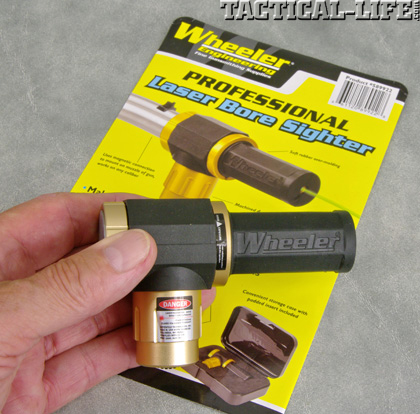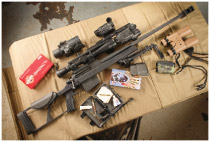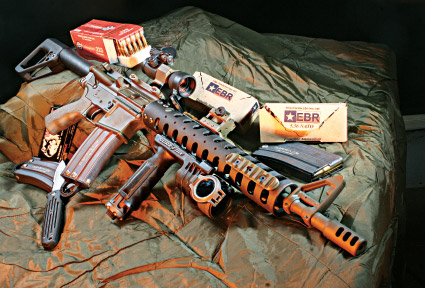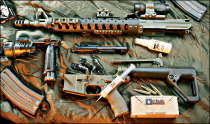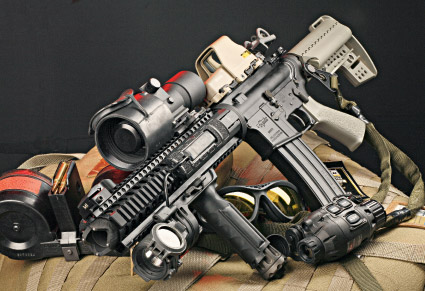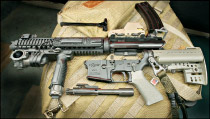If I had to name the three guns that are most frequently customized and for which the most after-market accessories exist, I would list the Colt 1911, the AR-15 and the Ruger 10/22. The patents on these designs expired long ago, so other manufacturers are free to reproduce and modify any and all components. The efficacy of doing so, however, depends on the popularity of the design and to what extent that design lends itself to accessorizing. All three of the aforementioned certainly qualify on that score!
New MRI Plinkers
Of the three guns mentioned let’s examine the newest and most innovative variations of Ruger’s 10/22. They’re from Magnum Research Industries (MRI), and they’re designated the MLR 1722 for the .22 LR version and the MLR 1722M for the .22 WMR (Win Mag Rimfire). We were sent an example of each. Both models can be had in one of five stocks: three Barracuda wood-laminated stocks, an ambidextrous thumbhole polymer stock and a more or less conventional Hogue stock. The guns sent us were the ambidextrous thumbhole in .22 LR and the forest camo Barracuda in .22 WMR. The other Barracuda color laminates are Nutmeg and Pepper (brown and black, respectively).
Advertisement — Continue Reading Below
The major design feature that sets these rifles apart is their Magnum Lite graphite fiber-wrapped bull barrels. MRI claims these barrels are six times stiffer than an all-steel barrel of equivalent weight. That’s true, but a wrapped barrel that weighs the same as a conventional barrel of equal length would necessarily possess a barrel diameter too large to be practical. Truth of the matter is, if both barrels are of the same length and weight, the steel barrel will be stiffer than the wrapped barrel. It’s similar to the misconception that fluting a barrel makes it stiffer. If you take a conventional barrel, measure its deflection and then flute it, it will be less stiff than before. It is only in the case of barrels of equal weight that the fluted barrel will prove to be stiffer.
The barrel lengths on these guns are 17 inches for the LR and 19 inches for the WMR. The .22 LR barrel alone weighs 13 ounces, and the longer WMR spout 16 ounces. The actual length of the wrapped section on the LR barrel is slighter longer than on the Magnum, even though it is 2 inches shorter in length. Overall gun weights are 4.25 pounds and 5.25 pounds, respectively. As you can well imagine, rifles this short and feather-light feel like toys. That’s by no means a bad thing; on the contrary, both handle and point like a dream.
Rifle Particulars
Advertisement — Continue Reading Below
There are two types of carbon fiber used for barrel wrapping, pitch fibers and PAN fibers. Pitch fibers are much more thermally conductive (barrels cool four times faster than all-steel, whereas pan fibers only marginally so), but pan fibers have a much stiffer stiffness-to-weight ratio. There are also two ways to wrap a barrel, one with the fibers running parallel to the bore, the other with fibers running perpendicular. On a plinking/hunting rifle like the MLR, for which barrel cooling rate isn’t a factor, orienting the pan fibers parallel to the bore makes the most sense. And indeed that’s how MRI does it.
The MLR receivers, which differ, of course, because of the cartridges in question, are CNC-machined from 6061-T6 aluminum forgings to tolerances tighter than those found on Ruger factory guns. They also differ from the original equipment manufacturer (OEM) versions in that they have integral Picatinny rails with eight ring positions on the LR and seven on the magnum. At the base of the rails are transverse holes, which I’m pretty sure are cosmetic rather than further attempts to lighten what are already very light rifles. I must say, it looks pretty cool!
The bolts, which are made of hardened, 4140 steel, are also machined to tighter-than-OEM tolerances. Because the specs for optimal accuracy in a semi-auto .22 LR are different from those for a bolt-action rifle, this gun employs a Benz chamber, which essentially is a chamber whose front half is reamed to slightly tighter tolerances with regard to diameter and throating and whose rear half is reamed more generously, relative to SAAMI specs, so as to better meet the optimal conditions for a semi-auto in terms of feeding, chambering and extraction. In short, the chamber’s snug cartridge-embrace up front serves to better align the bullet to the bore axis and shorten its “jump” for best accuracy, all the while ensuring more reliable semi-auto operation with all brands and types of ammo. The magnum version, however, employs a standard SAAMI spec chamber. Both guns come with the same rotary magazines and trigger groups as furnished on the respective Ruger guns. And why not, when the receivers are exactly the same as far as all working parts are concerned?
Advertisement — Continue Reading Below
Stock Options
The stocks on these guns are quite different from one another. The one furnished with the LR version is an injection-molded ambidextrous thumbhole of polypropylene with “fiber additives” for extra strength and rigidity. Each side is a mirror image of the other. Comb height is designed for scope compatibility, and there’s a palm swell on the grip. The Barracuda stock on the magnum version consisted of a green/gray/brown color combination; it’s also a thumbhole, but that’s about the only characteristic they share. Note, the barrels are partially bedded—the LR for the first 2.5 inches of barrel and the magnum the first 4 inches. From there to the muzzle both barrels are free floated. And the laminated stock is definitely not ambidextrous, but boy it sure feels good if you’re right-handed!
Glass And Ammo
Advertisement — Continue Reading Below
To ready the guns for a little range work, I was able to secure two newly released rimfire scopes from Leupold—a VX-1 2-7×28 and a VX-2 3-9×33 with an adjustable objective. Naturally, the latter went on the .22 magnum, because I planned to shoot it on the 100-yard range. The scope is available from the Custom Shop with Leupold’s CDS (Custom Dial System). You simply tell them what load you plan to use, and they furnish an elevation dial calibrated to that trajectory. The smaller scope went on the LR for shooting from the 50-yard mark. Given the fact that both guns have integral Picatinny rails, Weaver-type rings were used. With the scopes aboard, the smaller gun weighed just over 5 pounds and the magnum 6 pounds 2 ounces.
Ammo-wise, we were able to scrounge up four loads for each rifle. For the LR we used Federal Gold Medal Ultra and CCI’s Green Tag—both match loadings—and for the high velocity/plinking loads CCI’s Stingers and Winchester’s Power Points. For the WMR, we used Federal, Winchester, CCI and Remington loads, all of them with the exception of the Federal load 40-grain jacketed hollow points (the Federal was a 30-grain JHP).
Another gizmo I had the chance to use in conjunction with testing these two rifles was a new laser bore sighter from Wheeler Engineering. It is by far the easiest and fastest bore sighter I’ve ever used, and it works unlike any other. Instead of using the bore itself or a caliber-matching arbor, to which a grid is attached, to direct the laser beam downrange, the Wheeler Professional Laser Bore Sighter magnetically attaches to the muzzle of the firearm. The magnetic surface, which measures 1.1 inches in diameter, is perfectly flat and highly polished. You simply ease the powerful magnet toward the muzzle, allowing the unit to clamp thereon. You then simply turn on the laser and direct it to a surface 25 yards or so away, and adjust the reticle to coincide with it (the longest distance in my house is 66 feet, so I was a bit short of 25 yards). You really don’t need a shooting bench or a rest of any kind. I simply raised the gun to my shoulder to see where the reticle was in relation to the beam, made my windage and elevation adjustments, then rechecked. I repeated the process a couple of time and was done.
Advertisement — Continue Reading Below
On a 25-yard target the reticle should be adjusted to a level about an inch above the green laser dot; doing so guarantees a hit somewhere on a 14-inch square target at 100 yards, whatever the rifle cartridge. The laser in this unit is quite powerful and can be seen in overcast light conditions to 35-50 yards depending on the surface, and inside a house it’s very bright.
Obviously, for the Professional Laser Bore Sighter to work, it must be made reasonably square with the muzzle crown, and there should be no nicks or dings that would prevent full, square contact. Like all bore sighting devices, this unit is meant to save ammo when first sighting-in a rifle by getting your first shot to impact somewhere on a typical 100-yard target; it is not a substitute for fine tuning your zero once you’re on paper. These things are especially valuable when zeroing-in guns other than bolt actions and single shots, because you can’t remove the bolt and bore sight them the old fashioned way.
As to the accuracy of this unit, when I got to the range, my first shot with the .22 LR on a 50-yard target was within an inch of my aiming point, and the magnum was within 3 inches. Both would have been on paper at 100. Frankly, I didn’t think the barrel crown on a typical production rifle would be square enough to allow laser bore sight to work, but apparently it is.
Advertisement — Continue Reading Below
As expected, the match ammo in the LR version was more accurate than the high-velocity stuff. Indeed, it was impressively accurate, with the CCI Green Tag match ammo punching three consecutive five-shot groups that averaged .45 inch at 50 yards. And the consistency of the groups was remarkable, with only .03 inch of difference between the largest and smallest group! The Federal Gold Medal Match did almost as well, averaging .58 inch. Of the two high velocity loads, Winchester’s 40-grain Power Points took the gold with a .92-inch average at 50 yards.
Also as expected, the .22 WMR’s accuracy was nothing to write home about. Perhaps it’s a case of bad luck, but I can count on one hand the number of .22 WMRs I’ve tested over the years that shot groups under 2 inches at 100 yards—and this wasn’t one of them. Except for one failure to feed, both the WMR and the LR functioned perfectly, but the WMR just didn’t like any of the four loads tried. Only two of the 12 groups fired for record spanned less than 2 inches, and barely so. None were match loads; but then, there’s no company I know of that offers a match load in .22 WMR. That fact in and itself should tell us something. If there’s such a thing as an inherently accurate cartridge, the .22 LR is it—and the .22 WMR isn’t!
I like both Magnum Research guns, but to my eyes the Barracuda laminated stock is so much cooler than the ambidextrous polymer job. If I had my choice I’d go with the forest camo Barracuda in .22 LR. The MSRPs on these guns vary quite a bit, depending on which stock you choose. For more information, visit magnumresearch.com or call 508-635-4273.
Advertisement — Continue Reading Below
